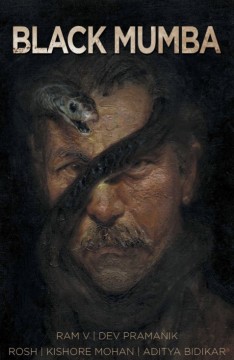Black Mumba (Ram V)
 Black Mumba is the debut graphic novel from writer Ram Venkatesan, an anthology of stories set in the sordid street level world of Mumbai, India. Linked by a central character, Detective Dev, who’s job it is to investigate some of the more horrific homicides and crimes this city has to offer. This book takes all the familiarity of the crime-noir genre and mixes it in with exotic, but not necessarily enticing, locations, social commentary and a touch of the supernatural too.
Black Mumba is the debut graphic novel from writer Ram Venkatesan, an anthology of stories set in the sordid street level world of Mumbai, India. Linked by a central character, Detective Dev, who’s job it is to investigate some of the more horrific homicides and crimes this city has to offer. This book takes all the familiarity of the crime-noir genre and mixes it in with exotic, but not necessarily enticing, locations, social commentary and a touch of the supernatural too.
 Publisher: Ram Venkatesan (Ram V) and Aditya Bidikar (bonus strip)
Publisher: Ram Venkatesan (Ram V) and Aditya Bidikar (bonus strip)
Writer: Ram Venkatesan
Artist: Devmalya Pramanik, Tomas Marijanovic, Kishore Mohan, Rosh, Aditya Bidikar, Somnath Pal, Nitin Veturkar
Price: TBC from blackmumbacomic.com
Our rating: [star rating=”4.5″]
To call Black Mumba a crime noir graphic novel would be wrong, pigeon-holing it as something less than what it is. While it exhibits all the hallmarks of a classic crime-noir set up (the hardboiled, well soiled detective; the dark, dank backstreet and alleyways that act as an appropriate backdrop to the sordid cases; a cast of unfortunate victims of a broken, uncaring, exploitative system) by setting it in the more unfamiliar setting of India’s Mumbai, it extrapolates this well worn genre from its more familiar American setting and puts it down deep in the heart of a city of extreme economic opposites.
They tell you to write about what you know, and so for this group of talented Indian writers and artists, obviously keen on crime-noir, Mumbai is the familiar. But, it makes for an interesting scenario and after reading the full four story collection, you could not help but think of Mumbai as anything other than a character in this whole affair. A sad, indelibly stained personality that has seen better days but has not given up on life just yet.
These may be fictional tales but the facts of recent Indian history and the crimes done by a wealthy few in power, on its own population, is where the real crimes have been committed. Forget the siphoning off of 20% of the daily take of grain from rat infested warehouses, but rather focus on the real life horror of a government that in 1975 coerced its very poorest and uneducated into a programme that saw millions sterilised, thereby attempting to stem the tsunami-like population flood that hasn’t shown signs of slowing down any time soon.
The comparison between the furry, filthy vermin that plague the dirty docks of a murky Mumbai and human atrocities is not necessarily the most subtle, but it cannot be ignored. Rats come in all shapes and sizes; no wonder our would-be hero with a heart is close to being a broken man when first we meet him, alone and contemplating suicide in the opening ironically title story, It’s A Wonderful World (from Ram V, Dev Pramanik, Tomas Marijanovic). Facing the reality of a world of abject poverty, where lives are plentiful but valueless would break any person. Yet, after a brief wobble, Dev the detective never seems to look back.
Indeed, by the end of this graphic novel, there is even the faintest glimmer of hope for him, as he allows himself a moment of nostalgic happiness as he remembers his first ever kiss. A moment brought on by his encounter with a neighbourhood ‘witch’, a reminder of the superstitious nature still clinging to many less developed communities across this continent. A ‘witch’ who has her own story to tell and her own history to divulge. A history that, like the story in story Rats In The Dark (the tale of a missing worker), can be taken as a snapshot of the darker side of India’s troubles and strifes true to the ages. These are well written, informative tales of individual woe that could very easily be lost in all the hustle and bustle of modern life, if not for a determined Dev, married to his job.
Ram V and his assorted stable of artists introduce the reader to a world of socio-economic inequality and that’s a world the reader can relate to. A world of faceless wealth and rampant exploitation, and a world one step away from being engulfed by the savagery of human nature, with animals of many shapes and sizes prevalent in many of these stories. (Animals as scavengers, like us humans, then.)
The artwork is appropriately dark and awash with tones of grey, but it is a professional looking book too. Pramanik (and Marijanovic’s art), for instance, on It’s A Wonderful World and The Witch of Boria House (with Aditya Bidikar), is extremely detailed and delicate in the line work, reminding us somewhat of Ivan Reis’s artwork, with the whole book not jarring too far off message, if you like, in terms of maintaining a certain consistency in art styles, which is important when introducing new characters and new stories to the wider world.
So, what is Black Mumba if not a crime-noir book? It’s a promising debut from a stable of Indian creators that takes a well loved genre and infuses it with animalistic symbolism, socio-historical sadness, and a central character who, after a worrying start, seems to find joy in a world that would challenge even the most optimistic of people.
A worthwhile read when it goes on general release later this summer.


